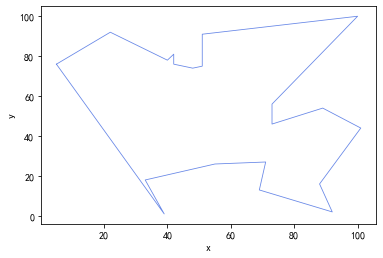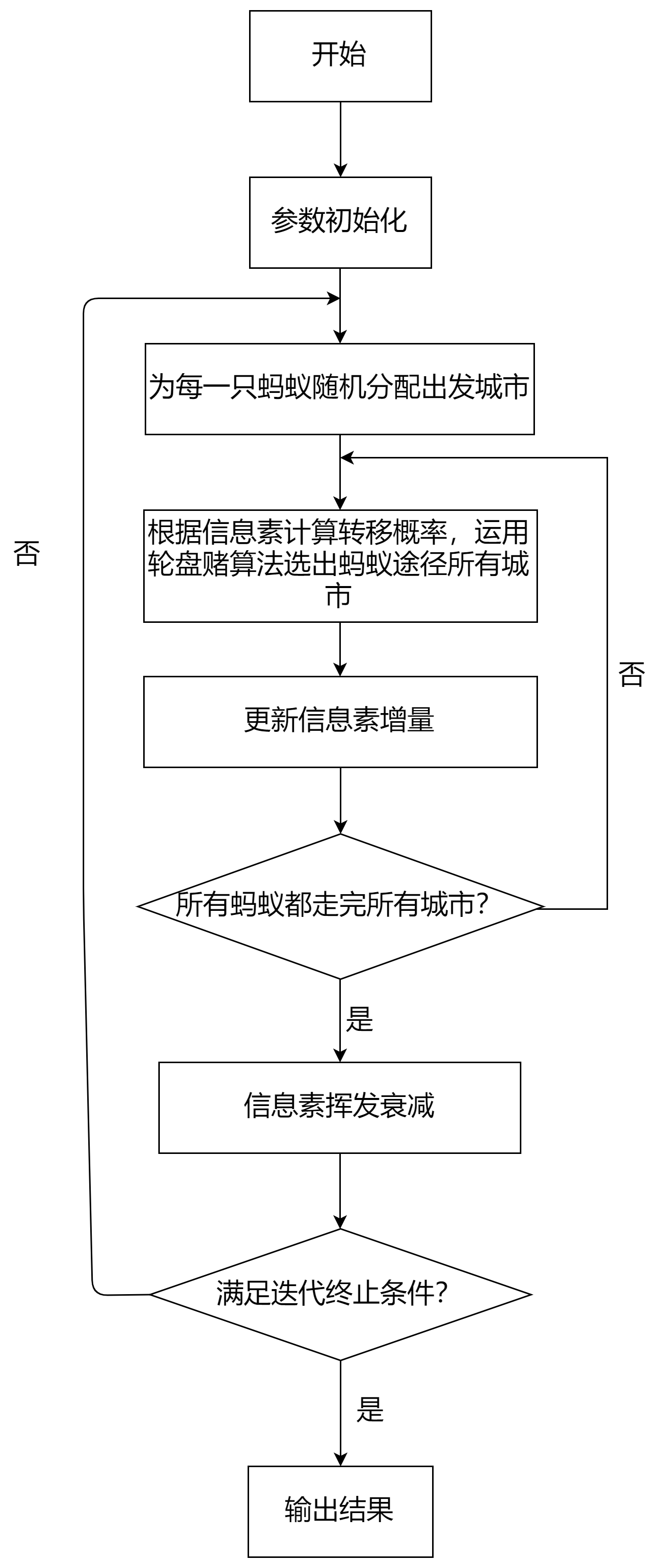Ant colony algorithm for TSP problem
Introduction to TSP issues
Traveling businessmen need to visit n cities and finally return to the starting city. They are required to visit each city only once. The optimization goal is to minimize the sum of distances.
Example solution results
20 city coordinates: (88, 16), (42, 76), (5, 76), (69, 13), (73, 56), (100, 100), (22, 92), (48, 74), (73, 46), (39, 1), (51, 75), (92, 2), (101, 44), (55, 26), (71, 27), (42, 81), (51, 91), (89, 54), (33, 18), (40, 78)
The result path is as follows:

Introduction to ant colony algorithm
Basic principle of ant colony algorithm
1. In the process of walking, ants will choose the road based on pheromone, choose the road with strong pheromone, and release pheromone in the path of walking. For the road that all ants have not passed, they will choose a road at random;
2. The pheromone concentration released by ants is related to the length, usually inversely proportional to the path length;
3. The path with high pheromone concentration will be selected by ants with greater probability to form positive feedback, and the pheromone concentration on the shortest path will become larger and larger. Finally, the ant colony will follow this shortest path.
Pheromone calculation formula, transfer probability, pheromone importance factor, heuristic function importance factor, pheromone volatilization factor and other details can be referred to Detailed explanation of ant colony algorithm and The solution of TSP -- ant colony algorithm
Two key steps of the algorithm
1. Selection: select the next city for the ant. The path with more pheromones has a high probability of being selected, which can be realized by roulette algorithm;
2. Pheromone update: recalculate the pheromone after a period of time (after the ant has completed a city or a complete path) (calculation method: historical accumulated pheromone - pheromone volatilization + ant walking release), There are three common methods for ant walking release: ant cycle algorithm (Q/L is used to calculate the ant walking release part after the ant walks a complete path, Q represents the amount of pheromone released by the ant, which is a constant, l represents the total length of the path), ant density algorithm (Q represents the ant walking release after the ant walks a city) Ant quantity algorithm (ant quantity, after an ant walks through a city, the ant's walking release is represented by Q/dij, and dij represents the distance between cities i and j).
Ant colony algorithm design
In the design of this algorithm, there are two layers of loops. The outer loop is the cycle of iteration times, and the inner loop traverses each ant. The pheromone increment updates the current pheromone after each ant walks the complete path, while the pheromone volatilization updates the current pheromone only after each generation of ants walk. The process is as follows:

# -*- coding: utf-8 -*-
"""
Tabu search algorithm TSP problem
Random in (0),100)20 points generated from 2D plane
Distance minimization
"""
import math
import random
import pandas as pd
import matplotlib.pyplot as plt
from matplotlib.pylab import mpl
mpl.rcParams['font.sans-serif'] = ['SimHei'] # Add this bar to make the graphics display Chinese
#Calculate the path distance, that is, the evaluation function
def calFitness(line,dis_matrix):
dis_sum = 0
dis = 0
for i in range(len(line)-1):
dis = dis_matrix.loc[line[i],line[i+1]]#Calculate distance
dis_sum = dis_sum+dis
dis = dis_matrix.loc[line[-1],line[0]]
dis_sum = dis_sum+dis
return round(dis_sum,1)
def intialize(CityCoordinates,antNum):
"""
Initialization, assigning the initial city to the ant
Input: CityCoordinates-City coordinates;antNum-Ant number
Output: cityList-List of initial cities of ants, and record the initial cities of ants;cityTabu-Ant city taboo list, which records that ants have not passed through the city
"""
cityList,cityTabu = [None]*antNum,[None]*antNum#initialization
for i in range(len(cityList)):
city = random.randint(0, len(CityCoordinates)-1)#Initial City, the default City serial number is 0, and the calculation starts
cityList[i] = [city]
cityTabu[i] = list(range(len(CityCoordinates)))
cityTabu[i].remove(city)
return cityList,cityTabu
def select(antCityList,antCityTabu,trans_p):
'''
Roulette selection: select all cities according to the departure city
Input: trans_p-Probability matrix;antCityTabu-Urban taboo list, i.e. without passing through the city;
Output: full city path-antCityList;
'''
while len(antCityTabu) > 0:
if len(antCityTabu) == 1:
nextCity = antCityTabu[0]
else:
fitness = []
for i in antCityTabu:fitness.append(trans_p.loc[antCityList[-1],i])#Take out the city transfer probability corresponding to antCityTabu
sumFitness = sum(fitness)
randNum = random.uniform(0, sumFitness)
accumulator = 0.0
for i, ele in enumerate(fitness):
accumulator += ele
if accumulator >= randNum:
nextCity = antCityTabu[i]
break
antCityList.append(nextCity)
antCityTabu.remove(nextCity)
return antCityList
def calTrans_p(pheromone,alpha,beta,dis_matrix,Q):
'''
Calculate the transition probability according to the pheromone
Input: pheromone-Current pheromone; alpha-Pheromone importance factor; beta-Heuristic function importance factor; dis_matrix-Distance matrix between cities; Q-Pheromone constant;
Output: current pheromone+increment-transProb
'''
transProb = Q/dis_matrix # Initialize the transProb storage transfer probability and calculate the increment at the same time
for i in range(len(transProb)):
for j in range(len(transProb)):
transProb.iloc[i,j] = pow(pheromone.iloc[i,j], alpha) * pow(transProb.iloc[i,j], beta)
return transProb
def updatePheromone(pheromone,fit,antCity,rho,Q):
'''
Update pheromone, ant week algorithm
Input: pheromone-Current pheromone; fit-Path length; antCity-route; rho-ρPheromone volatilization factor; Q-Pheromone constant
Output: updated pheromone-pheromone
'''
for i in range(len(antCity)-1):
pheromone.iloc[antCity[i],antCity[i+1]] += Q/fit
pheromone.iloc[antCity[-1],antCity[0]] += Q/fit
return pheromone
#Draw a path map
def draw_path(line,CityCoordinates):
x,y= [],[]
for i in line:
Coordinate = CityCoordinates[i]
x.append(Coordinate[0])
y.append(Coordinate[1])
x.append(x[0])
y.append(y[0])
plt.plot(x, y,'r-', color='#4169E1', alpha=0.8, linewidth=0.8)
plt.xlabel('x')
plt.ylabel('y')
plt.show()
if __name__ == '__main__':
#parameter
CityNum = 20#Number of cities
MinCoordinate = 0#Minimum value of two-dimensional coordinates
MaxCoordinate = 101#Maximum value of two-dimensional coordinates
iterMax = 100#Number of iterations
iterI = 1#Current iterations
#ACO parameters
antNum = 50#Ant number
alpha = 2#Pheromone importance factor
beta = 1#Heuristic function importance factor
rho = 0.2#Pheromone volatilization factor
Q = 100.0#constant
best_fit = math.pow(10,10)#Large initial value and store the optimal solution
best_line = []#Storage optimal path
#Randomly generate city data. The city serial number is 0,1,2,3
# CityCoordinates = [(random.randint(MinCoordinate,MaxCoordinate),random.randint(MinCoordinate,MaxCoordinate)) for i in range(CityNum)]
CityCoordinates = [(88, 16),(42, 76),(5, 76),(69, 13),(73, 56),(100, 100),(22, 92),(48, 74),(73, 46),(39, 1),(51, 75),(92, 2),(101, 44),(55, 26),(71, 27),(42, 81),(51, 91),(89, 54),(33, 18),(40, 78)]
#Calculate the distance between cities and generate a matrix
dis_matrix = pd.DataFrame(data=None,columns=range(len(CityCoordinates)),index=range(len(CityCoordinates)))
for i in range(len(CityCoordinates)):
xi,yi = CityCoordinates[i][0],CityCoordinates[i][1]
for j in range(len(CityCoordinates)):
xj,yj = CityCoordinates[j][0],CityCoordinates[j][1]
if (xi==xj) & (yi==yj):
dis_matrix.iloc[i,j] = round(math.pow(10,10))
else:
dis_matrix.iloc[i,j] = round(math.sqrt((xi-xj)**2+(yi-yj)**2),2)
pheromone = pd.DataFrame(data=Q,columns=range(len(CityCoordinates)),index=range(len(CityCoordinates)))#Initialize pheromone. All paths are Q
trans_p = calTrans_p(pheromone,alpha,beta,dis_matrix,Q)#Calculate the initial transition probability
while iterI <= iterMax:
'''
The pheromone reduction caused by environmental factors is updated once in each generation. After each ant in each generation completes the path, the pheromone increment update (using ant week model) and transfer probability update are carried out;
At the beginning of each generation, the starting city of ants is initialized first;
'''
antCityList,antCityTabu = intialize(CityCoordinates,antNum)#Initialize City
fitList = [None]*antNum#Fitness list
for i in range(antNum):#Select the cities of follow-up routes according to the transfer probability, and calculate the adaptation value
antCityList[i] = select(antCityList[i],antCityTabu[i],trans_p)
fitList[i] = calFitness(antCityList[i],dis_matrix)#Fitness, i.e. path length
pheromone = updatePheromone(pheromone,fitList[i],antCityList[i],rho,Q)#Update current ant pheromone increment
trans_p = calTrans_p(pheromone,alpha,beta,dis_matrix,Q)
if best_fit >= min(fitList):
best_fit = min(fitList)
best_line = antCityList[fitList.index(min(fitList))]
print(iterI,best_fit)#Print current algebra and best fit values
iterI += 1#Iteration count plus one
pheromone = pheromone*(1-rho)#Pheromone volatilization update
print(best_line)#Path order
draw_path(best_line,CityCoordinates)#Draw a path map